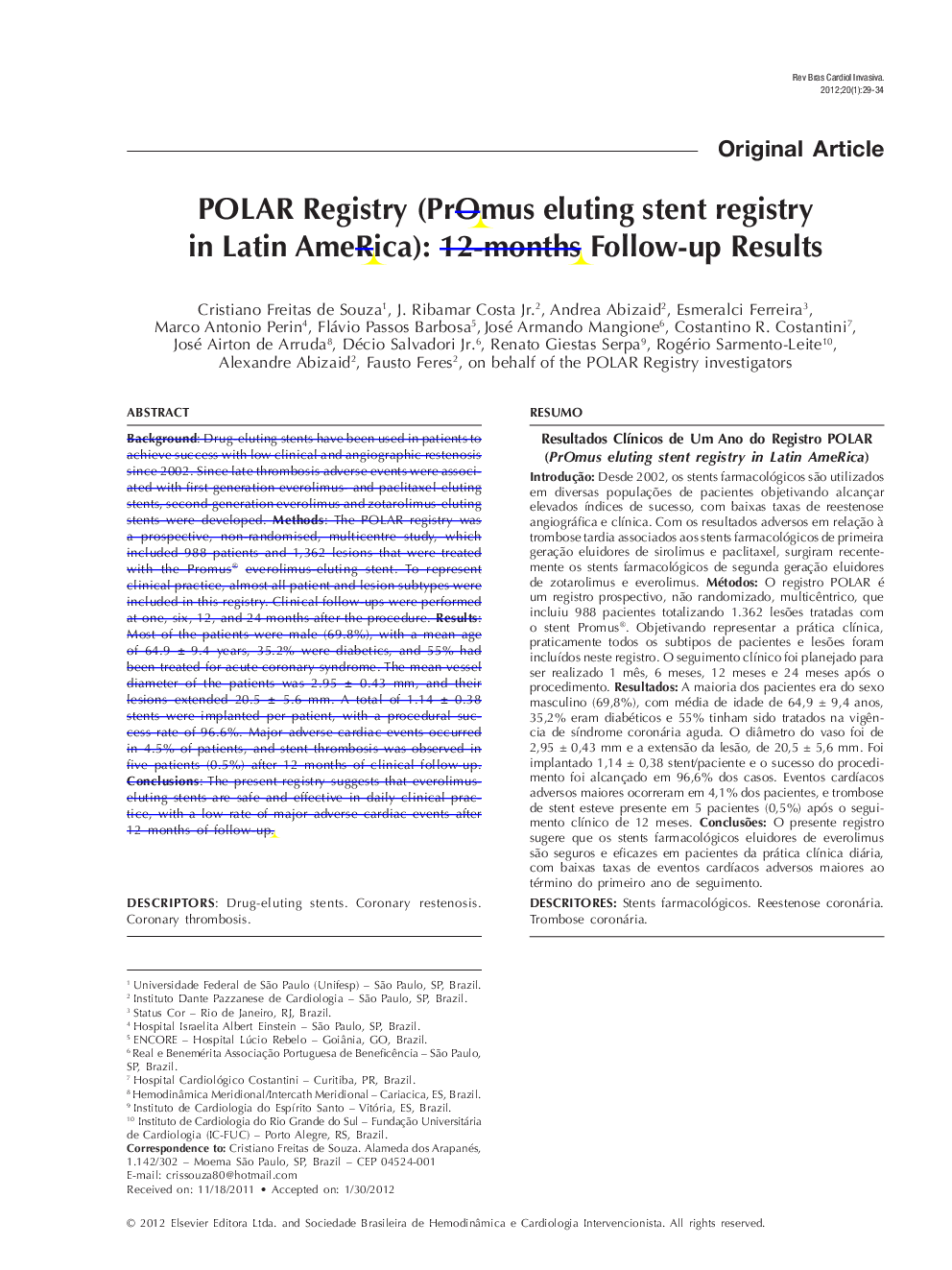| Article ID | Journal | Published Year | Pages | File Type |
|---|---|---|---|---|
| 3011914 | Revista Brasileira de Cardiologia Invasiva (English Edition) | 2012 | 6 Pages |
ABSTRACTBACKGROUNDDrug-eluting stents have been used since 2002 in different patient populations aiming to achieve high success rates with low clinical and angiographic restenosis rates. With the late thrombosis adverse events associated to the first generation sirolimus and paclitaxel-eluting stents, second-generation everolimus and zotarolimus-eluting stents has been recently developed.METHODSThe POLAR registry is a prospective, non-randomized, multicenter study, which included 988 patients, totaling 1,362 lesions treated with the everolimus-eluting stent Promus®. In order to represent the clinical practice, almost all subtypes of patients and lesions were included in this registry. Clinical follow-up was planned to be performed 1, 6, 12 and 24 months after the procedure.RESULTSMost patients were male (69.8%), with mean age of 64.9 ± 9.4 years, 35.2% were diabetics and 55% had been treated for acute coronary syndrome. Vessel diameter was 2.95 ± 0.43 mm and lesion extension was 20.5 ± 5.6 mm. A total of 1.14 ± 0.38 stent/patient were implanted and the procedural success rate was 96.6%. Major adverse cardiac events occurred in 4.5% of patients, and stent thrombosis was observed in 5 patients (0.5%) after a clinical follow-up of 12 months.CONCLUSIONSThe present registry suggests that everolimus-eluting stents are safe and effective in daily clinical practice patients, with a low rate of major adverse cardiac events at the end of the first year of follow-up.
RESUMOResultados Clínicos de Um Ano do Registro POLAR(PrOmus eluting stent registry in Latin AmeRica)IntroduçãoDesde 2002, os stents farmacológicos são utilizados em diversas populações de pacientes objetivando alcançar elevados índices de sucesso, com baixas taxas de reestenose angiográfica e clínica. Com os resultados adversos em relação à trombose tardia associados aos stents farmacológicos de primeira geração eluidores de sirolimus e paclitaxel, surgiram recentemente os stents farmacológicos de segunda geração eluidores de zotarolimus e everolimus.MétodosO registro POLAR é um registro prospectivo, não randomizado, multicêntrico, que incluiu 988 pacientes totalizando 1.362 lesões tratadas com o stent Promus®. Objetivando representar a prática clínica, praticamente todos os subtipos de pacientes e lesões foram incluídos neste registro. O seguimento clínico foi planejado para ser realizado 1 mês, 6 meses, 12 meses e 24 meses após o procedimento.ResultadosA maioria dos pacientes era do sexo masculino (69,8%), com média de idade de 64,9 ± 9,4 anos, 35,2% eram diabéticos e 55% tinham sido tratados na vigência de síndrome coronária aguda. O diâmetro do vaso foi de 2,95 ± 0,43 mm e a extensão da lesão, de 20,5 ± 5,6 mm. Foi implantado 1,14 ± 0,38 stent/paciente e o sucesso do procedimento foi alcançado em 96,6% dos casos. Eventos cardíacos adversos maiores ocorreram em 4,1% dos pacientes, e trombose de stent esteve presente em 5 pacientes (0,5%) após o seguimento clínico de 12 meses.ConclusõesO presente registro sugere que os stents farmacológicos eluidores de everolimus são seguros e eficazes em pacientes da prática clínica diária, com baixas taxas de eventos cardíacos adversos maiores ao término do primeiro ano de seguimento.
